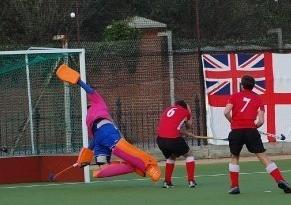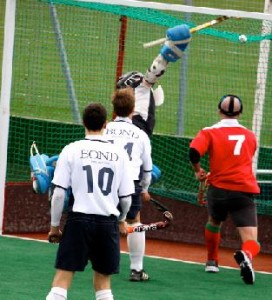The lob is a useful tactic for the opposition; trying to catch the goalkeeper off their line to beat them with an overhead flick. Although not the most regular form of shot, they are still tricky to deal with, and the goalkeeper needs to be aware of and know how to properly deal with such scoring opportunities. Being lobbed can often be an embarrassing experience if you fail to beat it, so you will want to do your best to keep the ball out of the goal!
Being lobbed
The main cause for being lobbed is being too far off your line. Seeing the open space to exploit, the shooter will look to try and lift the ball over you, since you will not be able to . Caught out and unable to get back, you can end up being embarrassed by a well taken lob. If you have come out early to meet the shot, then the attacker, if they are skilled enough, can lob you; putting you in a tricky spot as you have an ‘open net’ behind you.
In this video clip, you can see the goalkeeper get lobbed by a well placed drag flick at 1:05 playing time:
Staying deep
Being positioned deep within the D in the first place helps reduce the chances of being lobbed, and also making your life easier if you have to face being lobbed. Playing deep, not far off your line means you are already set in a good position to be able to block the incoming lob. The closer you are to the lob, the easier it is to cover it.
Technique
The way to beat a lob relies on agility to get back to make the save, with the athleticism of a well executed jump to reach into the save; using the glove to tip the ball over the bar to safety. The save can be broken into three stages, involving the goalkeeper moving into a suitable position to be able to block the incoming ball:
- move back to cover the ‘overhead’
- jump up in to touch
- push the ball over the bar/away to safety
Back stepping
In order to get there quickly enough to be in place to cover the lob, you will have to move with speed, backing up against the shot to be able to block it in time. Back step as quickly as possible, maintaining your balance, to get back to cover in time.
Turning sideways
In soccer, goalkeepers will turn side-on as they step back against the lob. The reason for this is that you will face the ball more as it drops. By turning sideways, you too can gain an advantage against the lob, allowing you to make the save successfully.
Reaching into the save
Jumping up against the lob, you need to leap up into reach the ball. Make sure you are explosive; exploding from your stance up into the save to be able to reach the ball.
Tipping the ball over
When making the save, it is important to get rid of the rebound, so you don’t make a ‘dangerous ball’ or give away an easy chance to tap the ball into the goal. Use the technique of tipping the ball over the bar to get the ball away from danger, just like soccer keepers do. Get under the ball and palm it up and over; a push into the ball will put it away with greater velocity.
Leaning back
If it is not possible to reach into the save, then you will have to try and reach back against the shot to make the save. With the speed of the ball, you can easily get caught out. Drag flicks during short corners are the other time when you will see a lob attempt, and it is easy enough to get caught out, having stepped off your line to challenge the angles. With yourself already beaten, you will have to reach back against the play to try and block it; cutting off its path.
Keeping it safe
Against a lob, it is more necessary to ‘keep it safe’ given the danger of allowing an easy goal. It is important to ‘make sure’, checking that you have it covered, so that you don’t give away the goal. The flight of the ball can be deceiving, so if you don’t watch it through, you may end up being made to look silly.
Notice how the ball has hit the top of the netting, but the goalkeeper still ‘makes sure’.
Soccer technique
Another useful to learn from ‘soccer’ (football), is how to deal with this situation. The model for dealing with a lob is based on soccer goalkeeping technique, so learning about the way soccer keepers play can only improve your ability to make such a save. Goalkeepers in this sport often face lobs, having to regularly stay deep and reach up against high shots to block. By watching soccer (which is easy in soccer mad countries) you should be able to pick up a thing or two. Reading guides on is also a good way of learning. Having friends who play goal in soccer is also very useful, as you can pick up a few ideas on how to deal with lobs, when being faced with them in hockey.
Pointers:
- stay deep in your D to prevent being lobbed
- back step into a position to block
- turn sideways to give yourself a better chance of making the save
- reach up into the save, extending out to touch the ball
- turn the ball over the crossbar to put it away to safety, rather than back in play
- ‘make sure’ on the lob so you don’t get beaten, even if it is going wide



A good article overall but i disaggree with some of the points. For example i don’t think that a dragflick from a short corner really qualifies as a “lob”. A lob is typically seen when the keeper charges out towards the player too late and the playeer lifts it over him. The ball really has to fly in a high arc for it to be a lob. In the video the keeper isn’t lobbed. he’s just short. He may have even benifited from playing less deep as he would have cut down the angles. The dragflick is just a high shot not a lob.
I agree with CormacDc in that a drag flick is not a lob. My definition of a lob is something that is dropping behind the goalie into the net whereas a drag flick is still rising as it passes the keeper.
Otherwise I think this is a good article, although I would suggest that another solution to the lob in hockey is to quckly close down the striker so that there is no way of them clearing the keeper and still getting the ball back down in time with enough forward momentum to reach the goal.
This differs from a soccer goalie as they can be lobbed from anywhere on the pitch rather than the restricted area of our ‘D’. This means they can’t afford to be too far from their goal line during open play whereas we can adopt a more aggressive position in the ‘D’, at least as far out as the P-spot while the ball is outside the 25.
Hello
We are a big french hockey club in Bordeaux (south west of France) and we are desesperatly looking for a goal keeper for next seasons for our irts team (men). Anyone interested ?
We can offer jobs and logement.
Simon
I wish I could go overseas to play hockey too bad I’m still heaps young.
Good post but I have to agree Cormac and oldfogie that drackflicks cant be lobs. I more think of a lob as like a scoop over your head. has to have a big ark.
Toby
For which teams are you looking for goalkeepers? At which level do you play?
Football